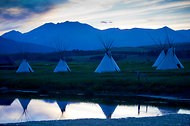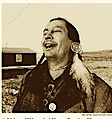Native American-based Mathematics Materials
Departments of Mathematics, CSUF and TMCC

Menu:
2019-2020 Info:
Office:
MH-157
Address:
CSUF Mathematics Dept.
Fullerton, CA 92831
Email:
cfunkhouser@fullerton.edu
Phone:
206-300-3322
Collaborators:
Charles Funkhouser PI
Harriet Edwards CoPI
Miles Pfahl CoPI (TMCC)
Patrick Weasel Head
Roberto Wheaton
Michael Little Crow
Shawn Jordan
FAQs

The following is a list of question frequently asked about our Project and some of the participants' thoughts about the FAQs:
Q: What is the title of this Project all about?
A: The source and basis of all the materials in this Project is American Indian culture. The mathematics content developed is that used in established undergraduate mathematics courses at Tribal and community colleges and universities. The culture and mathematics are INTEGRATED into one another, not meant to be stand alone materials.
Q: How and when did this Project get started?
A: The "spark" for this Project came from a classroom presentation of a Shoshone undergraduate student in secondary mathematics education at the University of Wyoming in 1998. Her name is Josephine Redman. Her micro-teaching lesson integrated the Native beading of apparel which her grandmother had taught her with a section on Gauss in her UW number theory course.
Her instructor, Dr. Charles Funkhouser, with Mrs. Redman's permission, initiated a collaboration with Miles Pfahl, a UW graduate student and instructor at Turtle Mountain Community College, to find other points of integration between American Indian culture and established undergraduate mathematics. Together with others from across the West, and with the generous support of the National Science Foundation in two DUE TUES awards, they have continued to develop, research and disseminate the connections between Native culture and undergraduate mathematics--to "Tend the Fire"--which Josephine ignited in her creative and profound way.
Q: What does mathematics have to do with Native American culture?
A: As one respondent to this question offered, "What does mathematics have to do with anything?" As before the initiation of this Project, the Project participants see mathematics as universal, everywhere, relevant in all domains, including in American Indian culture. Mathematics is our vehicle for finding out more about the world around us, including the universe of Native culture--just as any other aspect of the sciences or humanities.
And as you explore some of the lessons and materials which we have developed for this Project, we hope you'll find out more about this universal aspect of mathematics too!
Q: What is this project doing?
A: As you can see in the "Lessons" section of this website, we are developing integrative, classroom-ready lessons for use in your undergraduate mathematics classes. These are for your use, revision, customizing and enhancement to match your classroom needs and, as indicated, different Tribal backgrounds.
Additionally, we are continually disseminating these materials by a variety of traditional and technology-based means, and researching the transformational nature of these materials on undergradute mathematics education--especially in regard to student and instructor affect toward mathematics, American Indian culture, and diversity in the teaching of STEM generally.
Q: May anyone use the materials from the Project that are given on this website?
A: YES, and please do! As indicated in the previous FAQ, you are encouraged to use, revise and adapt the materials as you wish. All materials available in the "Lessons" section have been developed in commonly use platforms and formats, such as Word and Power Point for a PC or Mac. As part of the nature of funding of such an NSF Project, all posted artifacts are public domain and available to all for the advancement of mathematics education.
Q: Who is involved in this Project?
This Project is a National Science Foundation DUE-TUES sponsored collaboration between California State University-Fullerton and Turtle Mountain Community College in Belcourt, North Dakota. Additionally, the Project has many collaborators, materials developers, Tribal liaisons, and other participants throughout the Western and Plains states. Further information about participants can be found on the "Project Participants" link given on the homepage.
